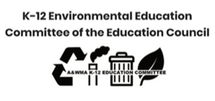In the past several years, the number of Environmental Education lessons available free and on-line has exploded. However, lessons on Air Quality and Water Quality are still rare. The Air & Waste Management Association (A&WMA) has a set of free and downloadable lessons that cover these topics for Grades K-12. You will find them listed below. They are designed for hands-on learning and can be useful for working on language arts and social studies skills as well as an understanding of science.
These Environmental Education Resource Guides (EERGs) are divided into separate lessons by class level (grades K-2, 3-5, 6-8, and 9-12). They are designed to develop critical thinking skills including observation, comparison, analysis, and problem-solving. Each of the lesson plans found in the EERGs has been written and field-tested by classroom teachers. The content has also been extensively reviewed for technical accuracy by AWMA members and other leading experts.
The Air Quality EERGs cover topics ranging from how to identify air pollutants, how they move through the air, and simple solutions for reducing pollution. The Water Quality EERGs focus on nonpoint source pollution, including runoff and soil erosion. A new lesson on Climate Change was recently developed for Grades 9-12.
Each packet begins with background materials for teachers. Members of the Public Education Committee of A&WMA are available to provide more technical information as well as advice on how to introduce these lessons. Feedback is welcome as we continue to improve these lessons.
Contact us at AWMAPublicEd@gmail.com.
Also included in these lessons and the supplement below are links to Environmental Education lessons provided by other organizations. These lessons have been reviewed for technical accuracy by members of the Public Education Committee who are all professionals in the Air Quality and Water Management fields.
These Environmental Education Resource Guides (EERGs) are divided into separate lessons by class level (grades K-2, 3-5, 6-8, and 9-12). They are designed to develop critical thinking skills including observation, comparison, analysis, and problem-solving. Each of the lesson plans found in the EERGs has been written and field-tested by classroom teachers. The content has also been extensively reviewed for technical accuracy by AWMA members and other leading experts.
The Air Quality EERGs cover topics ranging from how to identify air pollutants, how they move through the air, and simple solutions for reducing pollution. The Water Quality EERGs focus on nonpoint source pollution, including runoff and soil erosion. A new lesson on Climate Change was recently developed for Grades 9-12.
Each packet begins with background materials for teachers. Members of the Public Education Committee of A&WMA are available to provide more technical information as well as advice on how to introduce these lessons. Feedback is welcome as we continue to improve these lessons.
Contact us at AWMAPublicEd@gmail.com.
Also included in these lessons and the supplement below are links to Environmental Education lessons provided by other organizations. These lessons have been reviewed for technical accuracy by members of the Public Education Committee who are all professionals in the Air Quality and Water Management fields.
The naming convention for the files below:
AQ - Air Quality
NP - Non-Point Sources
SUST - Sustainability
Followed by the Grades that are covered, e.g., 9 - 12
Followed by the Lesson Name
Air Quality Lessons
| aq35_freq_flyers.pdf | |
| File Size: | 1465 kb |
| File Type: | |
| aq68_every_breath_you_take.pdf | |
| File Size: | 269 kb |
| File Type: | |
| aq912_oh3_and_me.pdf | |
| File Size: | 1343 kb |
| File Type: | |
| aqk2_we_care_about_air.pdf | |
| File Size: | 917 kb |
| File Type: | |
| np35_nasty_waters.pdf | |
| File Size: | 252 kb |
| File Type: | |
| np68_name_that_source.pdf | |
| File Size: | 2024 kb |
| File Type: | |
| np912_slip_slide_away.pdf | |
| File Size: | 5330 kb |
| File Type: | |
| npk2_hiking_we_will_go.pdf | |
| File Size: | 1559 kb |
| File Type: | |
| sust912_climate_change.pdf | |
| File Size: | 382 kb |
| File Type: | |
Non-Point Source Water Pollution Lessons
Sustainability Lessons
Advanced Placement Coursework
U.S. EPA Programs for High School and College Students
EPA is looking for teams of college students working to design solutions for a sustainable future. As part of our People, Prosperity and the Planet (P3) Award Program, you can submit an application to research, develop, design, and demonstrate solutions to real world challenges. The P3 competition highlights the use of scientific principles in creating innovative technology-based projects that achieve the mutual goals of improved quality of life, economic prosperity and protection of the planet.
EPA launched a ‘See a Bloom, Give It Room’ high school video challenge. Students in participating states can enter by creating a public safety video that explains how to spot harmful algal blooms and how to be safe around them. The contest is open to high school students or teams in the following states: Colorado, Iowa, Kansas, Missouri, Montana, North Dakota, Nebraska, South Dakota, Utah, and Wyoming.
EPA launched a ‘See a Bloom, Give It Room’ high school video challenge. Students in participating states can enter by creating a public safety video that explains how to spot harmful algal blooms and how to be safe around them. The contest is open to high school students or teams in the following states: Colorado, Iowa, Kansas, Missouri, Montana, North Dakota, Nebraska, South Dakota, Utah, and Wyoming.
